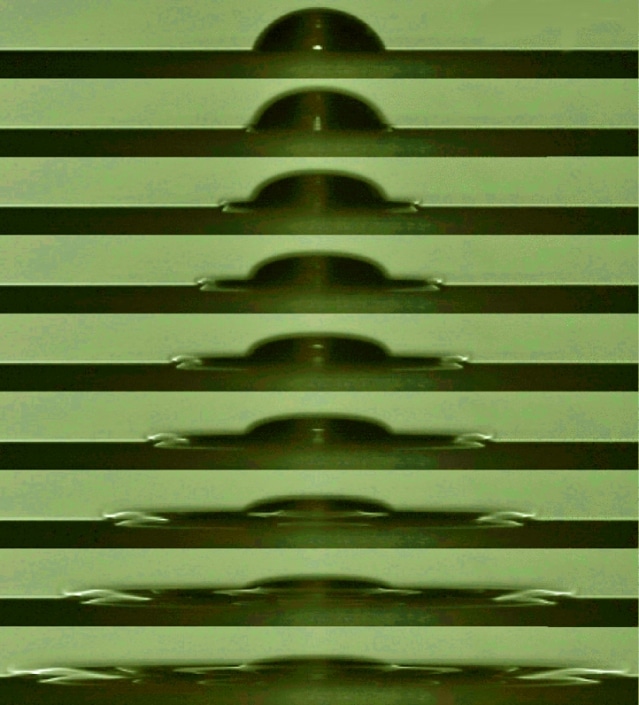Jun 30 2016
When raindrops fall into bodies of water, milk is added to a cup of coffee, and in other mixing and rinsing processes, you might wonder how one liquid is absorbed by the other. Small droplets can be absorbed so fast that our minds perceive it to be instantaneous. However, in reality, there is much more to the process than first meets the eye.
 The droplet begins to look like a hat as it spreads and the brim continues to spread until the droplet is mixed in with the second liquid.
The droplet begins to look like a hat as it spreads and the brim continues to spread until the droplet is mixed in with the second liquid.
In collaboration with Daniel Walls and Prof. Gerald Fuller from Stanford University, Dr. Simon Haward and Prof. Amy Shen from the Okinawa Institute of Science and Technology Graduate University (OIST) were able to, for the first time, capture the spreading of a droplet as it was immersed in a second mixable, or miscible, liquid. The results could have a far-reaching impact into general mixing, dilution, rinsing and washing processes, including how oil from oil spills mix with animal body oil. The paper describing these results has recently been published in Physical Review Fluids.
“There is always a clear interface between liquids that don’t mix, say oil and water. For example, in salad dressing you can clearly see the droplets,” Shen, co-author and head of OIST’s Micro/Bio/Nanofluidics Unit said. “But when you have two miscible liquids, like water and vinegar, they will integrate with each other rapidly and that process is pretty difficult to study because the interface is much less clear.”
In order to observe the interactions of multiple different pairs of miscible liquids, the team created a device that allowed a droplet on a glass slide to be slowly submerged into another liquid held below in a transparent cube. High speed cameras were set up around the device to document the way the drop spreads and then integrates into the second liquid. From the images, the team could see that the droplets spread in a way that made them look like little hats, with the brim continuing to spread over time until the droplet was fully integrated into the second liquid.
To further explore what happens in the liquid to create these droplet hats, the team added particles to the liquid and illuminated the particles with a laser. In this way, they could understand more about what was happening inside the fluid and why the droplet begins to look like a hat.
“We could see the motion of the fluid inside the droplets as the droplets spread out on the surface,” Haward, co-author and group leader of OIST’s Micro/Bio/Nanofluidics Unit said. “This made it very clear that the flow slides down around the top edges and the sides of the droplet, while the fluid in the center does not move.”
Corn Syrup Spreading in to Water
A drop of corn syrup spreads into water. The illuminated particles clearly show the way the corn syrup flows while it is spreading.
The team also used the same device, but replaced the slide with a syringe, to observe the interaction when a pendant drop from the syringe interacts with the surrounding mixable liquid. From this, they could see that again, the liquid flowed around the edges towards the bottom where a ‘draining’ type flow occurred.
Corn Syrup Pendant Drop in to Water
The corn syrup pendant drop exhibits a ‘draining’ flow.
“There is a qualitative difference in how the shape of liquid evolves when you have two miscible liquids instead of two immiscible liquids,” Walls, Ph.D. student at Stanford University said. “And this is the first time that the spreading of miscible liquids has been captured in this way.”
Haward added, “There are numerous potential applications. Understanding the spread of miscible liquids can be useful in many different fields.”
Source: http://www.oist.jp/